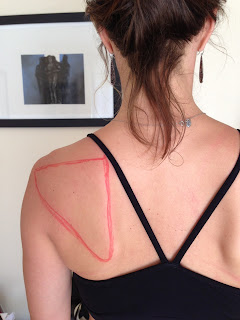by Baxter

Let’s talk about the shoulder blades today. Recently, while evaluating my newest batch of teacher trainees during their teaching intensive, I was surprised to hear the instructions to “move the shoulder blades toward the pelvis” when the arms were in the overhead position, such as in Urdhva Hastasana. I heard it in Warrior 1, in Utkatasana, in Downward-Facing Dog, and virtually anytime my young wards had the arms overhead. And I flinched each time they uttered it, which just about every one of them did for the four classes they taught. Without naming names, I should mention “always move your shoulder blades down your back” is an instruction that I have heard on many occasions from very experienced teachers. These trainees did not hear me utter such words, but I realized that some of their instructors were still using this outdated understanding. This is too simplistic, as it is not what actually needs to happen for healthy movement of the arms overhead and it can actually restrict the mobility of the shoulder joint for most students.
If you look at photos of Mr. Iyengar in the classic “Light on Yoga,” you can see that he is not doing that. His shoulder blades are clearly moving towards his arms, not away from them. (I refer you to the following plates: 12, 23, 42, 91 and 96.) So what is going on here, or more accurately, what is going on with the shoulder blades when the arms go overhead?
When your arms are hanging at your sides, your shoulder blades have several common ways they move: sliding upwards is called elevation, such as when you shrug your shoulders; sliding slightly downwards, called depression, like when you tug the bottom of a shirt downwards; sliding them apart or side ways, called protraction or abduction, like when you give yourself a hug; and squeezing them together called retraction or adduction, like when doing the Cobra with a doorknob.
 |
| Shoulder Blade in Neutral (Mountain Pose) |
In these four basic movements, the shoulder blades don’t rotate much. Instead, they slide around in the general way they sit on your back upper rib cage. But in addition to those movements, there are two more movements that require a bit more imagination on your part, since we can’t quite see what is going on under the skin and muscles. The first happens when you take your arms overhead, whether forward and up or out the sides and up. It is called upward rotation of the scapula. There is usually a bit of elevation of the entire shoulder blade from its neutral position, like in Mountain Pose, and a bit of protraction. But more noticeable is the out and up swing of the shoulder blade that allows for the greatest reach of the arms overhead.
 |
| Rotating Shoulder Blade |
The opposite action is required to get the arms back down to your sides, and is called downward rotation. It is likely that a bit of depression of the shoulder blade and retraction also accompanies this action.
My teacher Donald Moyer refers to the rotational movement of the shoulder blades as “traffic circles.” Depending on which way the arms are moving or how they are positioned on the body, the traffic around the outer edges of the circle will flow in one direction the other. As an example of how you might imagine this, you might start with your awareness at the lower tip of your right shoulder blade. You can likely reach around and feel this with your fingers of your left hand. When your arm goes overhead, the traffic flows up the outer edge, across the top edge from right to left, and down the inner edge back to the lower tip of the shoulder blade. You might have to imagine there is a central pivot point in the shoulder blade, and the traffic causes the shoulder blade to rotate around that point. Then the traffic flows in the opposite direction as the arm comes down to Mountain pose position.
You might be asking yourself if there are times when saying “move the shoulder blades down the back” would be appropriate? And the answer is yes. For instance, with new students who have hunched shoulder blades that are semi-permanently elevated and forward rounded, you might have to ask, show and encourage them to depress the shoulder blades in Mountain pose. I will keep a slight feeling of downward movement even as the arms approach the 90 degree mark, such as in Warrior 2 pose. In Warrior 2, there is a bit of upward rotation of the blades, but mostly protraction or widening away from the spine. The downward movement is helpful for those with the tendency to hike the shoulders in these lower arm positions.
But so what if you draw your shoulder blades down the back when they are overhead? What’s the big problem? Well, as your arms and shoulder blades swing up, the upper arm bone, the humerus, rolls slightly outwards, so as to have a better contact with the shoulder blade. If you then pull the “shoulder blades towards the pelvis”, the shoulder blades start to downwardly rotate, the arm bone pulls down with it, and the shoulder joint gets narrowed and pinched, meaning that the soft, non-bone structures can get pinched in an unhealthy way. I dislike demonstrating this “wrong” way of doing it for my students, because it quite literally pinches my gleno-humeral joint.
Having a clearer understanding of how the shoulder blades change positions on the rib cage will be very helpful to you as you try some of the shoulder openers we share with you because so many of them work more effectively if you encourage the upward rotation, protraction and elevation of the scapulae I have shared with you here today (see
Featured Sequence: Opening Tight Shoulders and future posts about the individual poses).